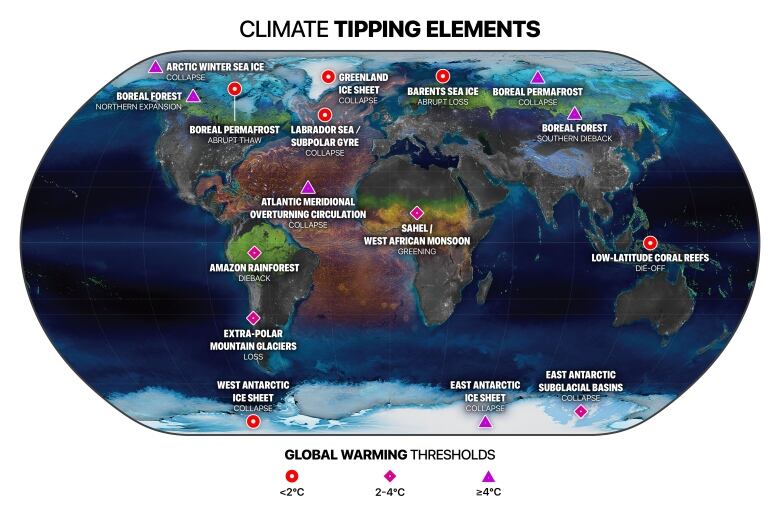Imminent collapse of Atlantic current could lead to sudden, irreversible climate impacts, new study suggests.

England and France could suddenly get a new, colder climate, as the ocean current that gives them their normally mild winters is close to collapse, a new study suggests.
The current known as the Atlantic Meridional Overturning Circulation (AMOC), crucial for warming Western Europe, could disappear as soon as 2025, according to research published this week in Nature Communications. And that would literally cast a sudden chill over the region.
The authors, Peter Ditlevsen and his sister, statistics professor Susanne Ditlevsen at the University of Copenhagen, found signs that we’re close to the “tipping point” that will trigger the current’s demise.
It’s just one climate signal suggesting we may now be getting dangerously close to some irreversible climate “tipping points” that scientists have warned about. Here’s what that means.
What exactly is a tipping point?
When it comes to climate change, a tipping point is a major, irreversible change that happens suddenly when a certain threshold is reached, such as a certain temperature.
We understand most changes as being gradual and linear (such as more heat waves as the average global temperature increases). In theory, those can be gradually reduced and even reversed if we cut and remove harmful emissions from the atmosphere.
But tipping points are different. They can happen suddenly, like an on-off switch, pushing climate systems into a completely new state. And they’re generally irreversible or difficult to reverse.
“The irreversibility is the really scary part,” said Vasilis Dakos, a researcher who has studied early warning signs of approaching transition or tipping points at the Centre national de la recherche scientifique in Montpellier, France.

What’s the climate tipping point for the Atlantic that everyone’s talking about this week?
The new study gives a stark climate example: England and France have milder winters than most of southern Canada despite being at a similar latitude. That’s thanks to the Atlantic Meridional Overturning Circulation (AMOC), combined with the Gulf Stream. The AMOC is part of a global conveyor belt that circulates warm water from the tropics to colder regions and vice versa.
Models predict an important climate tipping point will come when the AMOC shuts down or collapses, and stops circulating heat through the Atlantic. That’s because it’s powered by the sinking of dense salt water in the North Atlantic, and that process is getting swamped by the influx of lighter, freshwater from rapidly melting ice in Greenland.
“Then the conveyor stops,” explained Peter Ditlevsen.
The study says the collapse will happen as early as 2025 and no later than 2095.

The last time that current collapsed and was restored, during the last ice age period, it caused temperature fluctuations of 10 to 15 C in just a decade, and signs of its impact could be seen all over the world, Peter Ditlevsen said.
This time, the researchers predict the AMOC’s collapse will, among other things:
- Suddenly, give England and France a climate similar to that in southern Canada, which could cause huge damage to those countries’ ability to grow food.
- Heat up northern Africa, which is already experiencing extreme heat and droughts, since the hot, tropical water will stay there instead of heading north.
- Bring more storms and cause changes to rain and snow in Canada’s east and the U.S., including drying of the mid-American plains.
(On the upside, Peter Ditlevsen assures us that it won’t trigger an ice age within a few weeks as it did in the film The Day After Tomorrow).
How can you tell if we are nearing a tipping point?
There are a couple of key signs that are “universal” in predicting tipping points, according to Peter Ditlevsen:
- Wild swings to extremes (such as temperature) that indicate instability.
- Slower return to the average temperature.
Dakos likens it to being in a canoe that is getting slimmer and slimmer, making it less stable, and causing it to rock from side to side.
This is something researchers have seen evidence of in previous climatic changes the Earth has gone through, such as at the end of the last ice age 12,000 years ago, which is when the AMOC last collapsed.
In the case of the AMOC, researchers have been measuring its temperature, which they’ve correlated to other measurements made with satellites, submarine cables and moored instruments since 2014.
Using that temperature correlation allowed them to estimate AMOC over a longer period of time, back to 1870. In doing so, the researchers noticed signs that a tipping point is approaching. By extrapolating, they’ve estimated when that is — sometime in the next two to 72 years.
“I think one of the major take-home messages from our paper is that it could possibly happen much earlier than what is believed,” said Susanne Ditlevsen. “And I think that’s very worrisome.”
However, the researchers cautioned that this assumes that the temperature measurements have been properly correlated to be a “true measure” of the current. If that isn’t the case, then their predictions may not be as accurate.
Is climate change bringing us closer to any other environmental tipping points?
Yes. Examples of tipping points that are predicted will likely happen around 1.5 C of warming include the abrupt thaw of permafrost in the boreal forest (including Canada’s), the disappearance of a current in the Labrador Sea, the collapse of ice sheets in Greenland and West Antarctica, and the die-off of low-latitude coral reefs, such as Australia’s Great Barrier Reef.
Each of those events are already possible, scientists say, and could have a huge impact on other systems. For example, if permafrost thaws, the huge amounts of carbon stored in it would be released into the atmosphere all at once.

Some scientists think we’ve already hit some tipping points.
Record-breaking heat in many parts of the world this summer may also be a glimpse of completely new climate regimes and a step beyond increasing variation, they say.
University of Exeter climate researcher Tim Lenton told Inside Climate News earlier this month that the “extraordinary extremes” in weather we’ve been experiencing this summer could be an early warning.
“These extraordinary extremes could be an early warning of tipping points toward different weather or sea ice or fire regimes,” University of Exeter climate researcher Tim Lenton “We call it ‘flickering’ when a complex system starts to briefly sample a new regime before tipping into it. Let’s hope I’m wrong on that.”

All these heat waves are the new normal, scientists say
Climate change experts are warning that extreme weather and climate-related disasters could increase as punishing heat waves continue across much of the northern hemisphere.
Dakos said that’s a step beyond rocking a canoe — more like dipping into the water briefly, but managing to right the boat.
That’s been observed in the past, toward the end of the ice age, when the climate flickered repeatedly into a cold state and back to a warmer state again before making a permanent transition to an interglacial state.
But David Armstrong McKay, who studies tipping points at the University of Exeter, doesn’t think there’s much evidence that we’re flickering into new regimes yet.
“I think most of the extremes we’ve been seeing is simply because of that thing or the long term baseline is going up. That means that you’re shifting up the natural range of variability into new territory.”

Is it too late to stop the Earth from reaching tipping points?
No. Cutting and removing emissions can reduce the likelihood that we’ll hit them, says McKay.
In fact, some tipping points could be avoided if global warming overshoots 1.5 C in the coming years, but comes back down due to rapid cuts in emissions.
“Even if we cross some tipping points, we can still reduce the risk of crossing others by cutting emissions, which will also reduce negative climate change impacts that aren’t triggered by tipping points,” he said.
Finally, many tipping points rely on more than only temperature and carbon emissions, McKay said. “There are other factors like deforestation, for example, and other human activity.” That means there are other things people can do to reduce the risk that we’ll trigger them.
What if we do hit one?
McKay says it’s something that governments and planners must start considering.
“If some of these tipping points are crossed … there are these big impacts that can be locked in,” he said. “That’s something to think about in terms of adaptation planning.”
ABOUT THE AUTHOR

Science, climate, environment reporter
Emily Chung covers science, the environment and climate for CBC News. She has previously worked as a digital journalist for CBC Ottawa and as an occasional producer at CBC’s Quirks & Quarks. She has a PhD in chemistry from the University of British Columbia. In 2019, she was part of the team that won a Digital Publishing Award for best newsletter for “What on Earth.” You can email story ideas to Emily.Chung@cbc.ca.
With files from Inayat Singh and James Westman
*****
Credit belongs to : www.cbc.ca
 Atin Ito First Filipino Community Newspaper in Ontario
Atin Ito First Filipino Community Newspaper in Ontario






